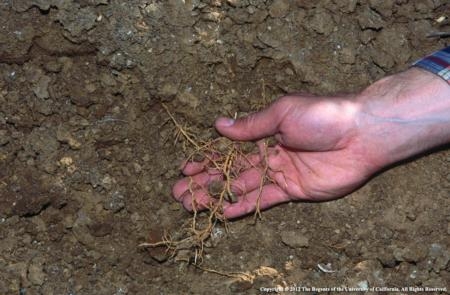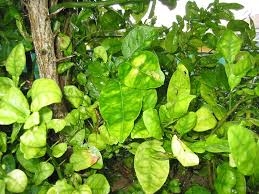- Author: Ben Faber
Translating the science of managing HLB
Your resource for learning about existing and new tools being developed by researchers to protect and manage citrus from the causative agent of huanglongbing (HLB).
Research Snapshots
|
See how scientists are working to control HLB by reading short snapshots about their research. Topics include:
|
Click on the links below to explore the snapshots!
Questions?
We have the answers!
Growers and end-user audiences can use this PowerPoint presentation which has been tailored for their use. It provides general background on the genetics that are used to modify crops and information on state and national regulatory approaches and consumer attitudes.
Examples of the questions that are addressed:
- What are the general processes of genetically modifying plants and insects?
- When and where did huanglongbing (HLB) come from?
- What are some genetic approaches to controlling HLB?
- What is consumer response to engineered crops and foods?
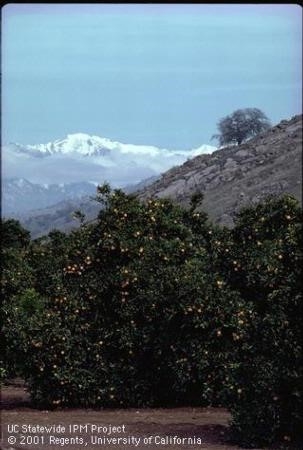
- Author: Ben Faber
|
New ‘Candidatus Liberibacter' Pathosystems Focus Issue from APS (American Phytopathological Society) |
|||
|
Read the great review of the bacteria that causes Citrus Huanglongbing and then the abstracts of the articles in this edition of Phytopathology. The review itself is pretty comprehensive, however you can't read the full articles contained in the editon without paying. But this gives you an idea of the extent of work being done, even though the language may be quite technical. The 18 articles in this Phytopathology Focus Issue showcase the enormous research efforts made by the scientific community, giving rise to major advances and achievements in a short time often through multidisciplinary approaches applied to the bacterium, psyllid vector, and plant host. Preview two editors' pick below or see the full Focus Issue. |
|||
|
Transcriptome Profiling of ‘Candidatus Liberibacter asiaticus' in Citrus and Psyllids |
|||
|
|||
|
Alves et al. explored Huanglongbing (HLB) presence and absence over 13 years in citrus orchards in Brazil and compared two hierarchical Bayesian modeling approaches to link climatic factors to the spatial distribution of HLB prevalence. They found an inverse relationship between HLB prevalence and mean temperature during the dry season, but wind speed, rainfall, and proximity of other HLB contributed to HLB prevalence. The results further our understanding of environmental factors associated with disease distribution and spread and assists policymakers in defining regions at risk of HLB outbreaks to help guide monitoring strategies that mitigate further spread of HLB. |
HLB symptoms
- Author: Ben Faber
A $1.5 million emergency grant is enabling UC Riverside scientists to find plants impervious to a disease threatening America's citrus fruit supply.
Citrus Greening Disease — also known as Huanglongbing, or HLB — results in fruit that is bitter and worthless. It has crippled Florida's citrus industry and has already been detected in California, which grows 80% of America's fresh citrus. An estimated 267,000 acres of Golden State oranges, lemons, grapefruits, and mandarins are at stake.
For these reasons, the National Institute of Food and Agriculture is supporting scientists at UCR, the University of Florida, and the U.S. Department of Agriculture's Agricultural Research Service in their search for plants with natural tolerance to HLB.
“If you find a disease affecting your crops, a good first step is to look for plants that are able to grow and produce despite infection,” said UCR geneticist Danelle Seymour. “Then you can start to identify the genetic basis of the disease tolerance and make sure the next generation of plants includes these genes.”
Following this recipe, Seymour and UCR plant pathologist Philippe Rolshausen will examine a set of 350 citrus hybrids developed and grown by project collaborators in Florida. All trees in the set are already infected with HLB, yet they live longer, are healthier, and yield more fruit than their infected relatives.
While there are a number of projects searching for different solutions to the threat of HLB, this project is different because the plants being tested were all grown in an environment endemic to the disease. Additionally, the number of plants they're able to test is unusually large.
“The environment in which these plants were grown means we can be confident that these rootstocks will enhance tree health and yield in HLB-affected areas,” Seymour said. “Also, because our data set is so large, we've got the opportunity to identify plants with levels of tolerance that exceed current commercial varieties.”
In addition to searching for parts of the hearty hybrids' genomes responsible for their tolerance to HLB, scientists will also be checking for plants that have resistance to other pathogens that are already in California.
Citrus in the state is also threatened by nematodes that chew up roots, preventing plants from taking up nutrients, and by phytophthora, a type of water mold that causes rotting roots.
By searching not only for a solution to the looming threat of HLB but also to problems that have already taken root in California, scientists are hoping to ensure that citrus won't need to be imported from HLB-free countries and costs stay low for both local growers and consumers.
“This way, we're making sure the next generation of rootstocks will include the right genes and that we're being as efficient as possible in our breeding practices,” Seymour said.
ACP nymph image by Sam Droege, USGS
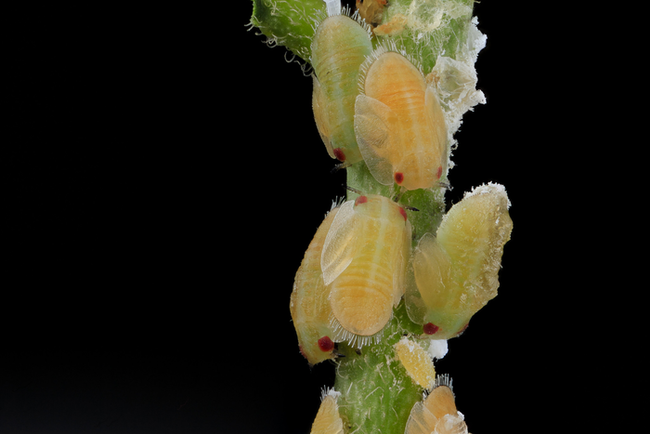
- Author: Ben Faber
Citrus greening disease can infect an entire tree weeks before symptoms appear
Ashley Carlin
American Phytopathological Society
For the first time ever, scientists have been able to measure the speed of a bacterium that causes the incurable citrus greening disease. Citrus greening disease (also known as Huanglongbing) is the most devastating citrus disease in the world. Afflicted trees grow yellow leaves and low-quality fruit and eventually stop producing altogether, resulting in enormous economic losses to farmers.
Small insects carry the causal bacteria, Candidatus Liberibacter asiaticus (CLas), and inject it when they feed on a tree's sap. CLas also relies on this sap to grow and spread throughout the tree. Using a new statistical modeling analysis and measurement approach, plant pathologists were able to follow CLas on its journey through a tree.
“We found that CLas can move at average speed of 2.9 to 3.8 cm per day. At these speeds a tree that is 3 meters in height will be fully colonized by CLas in around 80 to 100 days, and this is faster than the symptoms appear, which generally takes at least 4 months,” explained Silvio A. Lopes, a plant pathologist based at Fundecitrus, research institution maintained by citrus growers of the State of Sao Paulo in Brazil.
In other words, by the time growers see the symptoms of citrus greening disease, the tree has already been infected from the roots on up, which explains why removing symptomatic branches isn't enough to cure a diseased tree.
Lopes and colleagues also studied the impact of temperature on the speed of colonization. They already knew that CLas does not multiply well in hot or cold environments—but now they have more specific numbers.
“We estimated that 25.7°C (78°F) was the best condition for CLas to move from one side to the other side of the tree,” said Lopes. This is the first time impact of temperature on plant colonization of CLas has been experimentally demonstrated. “The grower can use this information to select areas less risky for planting citrus trees.”
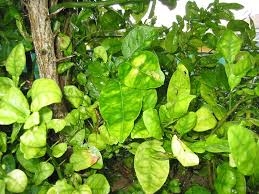
- Author: Ben Faber
Huanglongbing (HLB) and its causal agent Candidatus Liberibacter asiaticus (CLas) are a serious problem for the US citrus industry, with Florida and Texas already heavily affected, and California at an early stage. Rootstock cultivars with genetic tolerance to HLB improve tree health, fruit production, and fruit quality in HLB-affected orchards, but even the best rootstock available suffers large yield losses when infected. Further gains in tolerance or resistance to HLB are urgently needed to sustain the industry. Field trees in Florida are now all infected with CLas, providing an opportunity to screen thousands of trees for overall performance in environments with high disease pressure. Previous work to create and evaluate over 300 new rootstock hybrids across three HLB- endemic regions in Florida in replicated sweet orange field trials will be leveraged to deliver the best performing HLB-tolerant rootstocks for commercial release, including expanded collection of performance information over the next two years (Objective 1). Top performing rootstocks will be further screened for resistance to Phytophthora and other relevant soil-borne pathogens to ensure adoption in HLB-endemic and HLB-threatened regions. This extensive set of phenotypic data will be integrated with genetic information to identify the genetic control of HLB-tolerance and other important traits, enabling rapid selection of superior tolerant hybrid rootstocks in future breeding cycles (Objective 2). Commercial testing and release of rootstocks will occur in close consultation with industry members and will be disseminated to stakeholders at all levels through virtual and in- person seminars and large industry events.
PERFORMANCE OF 300 HYBRIDS IN ESTABLISHED TRIALS TO MAP HUANGLONGBING TOLERANCE/RESISTANCE GENES AND RELEASE SUPERIOR NEW ROOTSTOCKS
Seymour, D. K.; Deng, ZH, .; Rolshausen, PH, .; Bowman, KI, D.; Albrecht, UT, .
